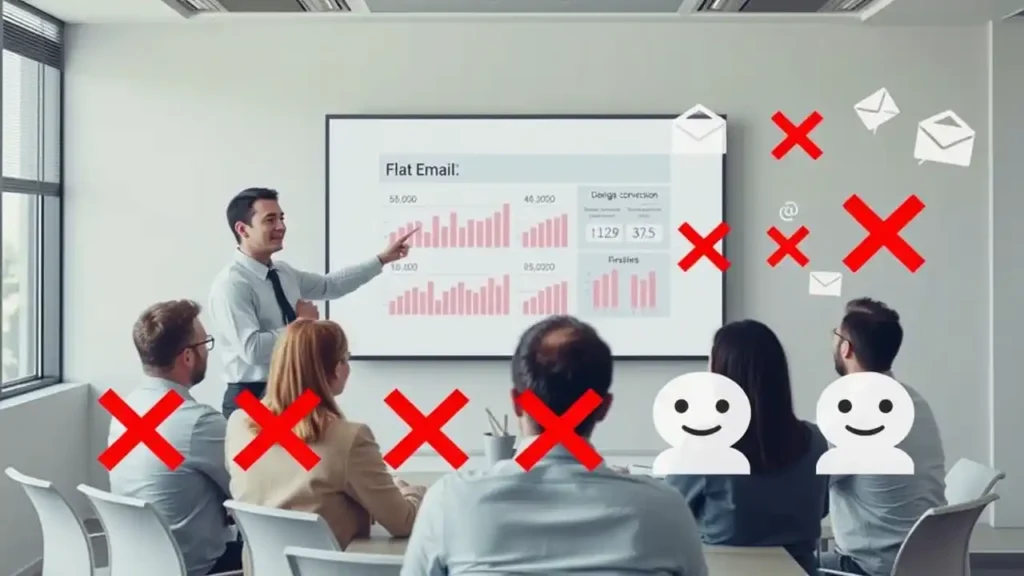Table of Contents
- 1 Quick Answer
- 2 🔍 Understanding Email Marketing Analytics
- 3 📊 Key Email Marketing Metrics to Track
- 4 🌟 Final Takeaway: If You’re Not Tracking, You’re Losing!
- 5 Advanced Metrics for Performance Tracking
- 6 Best Tools for Email Marketing Analytics
- 7 How to Optimize Email Campaigns with Analytics
- 8 Additional Key Aspects of Email Marketing Analytics
- 9 Key Takeaways: Master Email Marketing Analytics or Get Left Behind! 🚀
- 10 Share this article on social media
Quick Answer
If you’re serious about email marketing analytics, you can’t afford to ignore the data behind your campaigns. 📊
Miss the right metrics, and you’ll waste time, money, and potential revenue.
👉 Before diving in, check out Email Marketing: The Critical Basics You Can’t Afford to Ignore to master the foundations.
Now, here’s what you need to know right now 👇
🚀 What is Email Marketing Analytics?
Email marketing analytics is the process of tracking, measuring, and analyzing your email campaigns to boost engagement, conversions, and revenue.
Without analytics, you’re flying blind.
It helps you:
✅ Understand what’s working (and what’s failing).
✅ Track how subscribers interact with your emails.
✅ Optimize campaigns for higher ROI.
📊 Key Metrics to Track
Not all metrics matter. Focus on these essential email campaign metrics:
- 🔵 Open Rate – How many people actually open your email? 👀
- 🔵 Click-Through Rate (CTR) – Are they clicking your links? 🔗
- 🔵 Conversion Rate – Do your emails generate sales or leads? 💰
- 🔵 Bounce Rate – How many emails never reach the inbox? ❌
- 🔵 Unsubscribe Rate – Are you losing too many subscribers? 📉
🔧 Best Tools for Analytics
To measure email performance tracking, use the right tools:
- 🔵 Google Analytics + UTM parameters for deep tracking.
- 🔵 ESP dashboards (GetResponse, MailerLite, AWeber, etc.).
- 🔵 Advanced heatmaps to track user behavior.
🎯 How to Optimize Based on Data
Analyzing data is useless if you don’t act on it! Here’s how to use your email marketing insights:
✅ Test & improve subject lines to increase open rates.
✅ Refine CTA placements to boost click-through rates.
✅ Optimize send times to maximize engagement.
✅ Reduce bounces by improving email deliverability analytics.
🚀 Now, let’s break it all down step by step! Keep reading! 👇

🔍 Understanding Email Marketing Analytics
❓ What is Email Marketing Analytics?
Are you tracking your email marketing analytics, or are you blindly sending emails, hoping for the best? 🚨
If you’re not analyzing your campaigns, you’re losing money, leads, and engagement.
👉 Email marketing analytics is the process of tracking, measuring, and optimizing your email campaigns to maximize performance and revenue.
It helps you:
✅ Measure email campaign metrics like open rates, CTR, and conversions.
✅ Improve email deliverability analytics to reach more inboxes.
✅ Track email campaign performance and boost ROI.
✅ Use email engagement analysis to understand subscriber behavior.
🚀 Why It Matters for Your Email Strategy
Without email marketing analytics, you’re wasting your efforts. ❌
Here’s why data-driven email marketing is non-negotiable:
📊 Better Decision-Making – Use email data analytics to understand what works and what flops.
🎯 Higher Conversions – Optimize email conversion tracking to turn readers into buyers.
📈 Improved Engagement – Use email KPI measurement to fine-tune content and timing.
💰 Stronger ROI – Get actionable email marketing insights to increase revenue.
Table: Key Email Metrics You MUST Track 📊
| Metric | What It Measures 🚀 | Why It Matters 🎯 |
|---|---|---|
| Open Rate | % of people opening emails | Indicates subject line strength |
| Click-Through Rate (CTR) | % clicking a link | Shows content effectiveness |
| Conversion Rate | % taking desired action | Tracks sales & lead generation |
| Bounce Rate | % of undelivered emails | Helps fix email deliverability analytics |
| Unsubscribe Rate | % of people leaving your list | Measures audience engagement |
💡 Key Takeaway: If you’re not tracking, analyzing, and optimizing, you’re losing subscribers, sales, and revenue.

📊 Key Email Marketing Metrics to Track
🔍 Essential Email KPIs
Are you tracking your email marketing analytics correctly, or are you sending campaigns without knowing what works? 🚨 If you’re not measuring the right email campaign metrics, you’re losing engagement, conversions, and revenue!
Here are the critical KPIs you need to monitor:
📈 Open Rate – How many recipients open your email?
What it is: Measures the percentage of recipients who open your email.
Why it matters: A low open rate means your subject lines aren’t compelling or your emails land in spam.
How to improve:
✅ Write engaging subject lines ✅ Personalize your emails ✅ Optimize email deliverability analytics to avoid spam folders
🔍 Click-Through Rate (CTR) – How many recipients click on a link?
What it is: Measures the percentage of recipients who clicked a link in your email.
Why it matters: A high CTR indicates strong email engagement analysis, while a low one means your content isn’t converting.
How to improve:
✅ Use clear CTAs with action-driven language
✅ Add buttons instead of just text links
✅ A/B test different content formats
🏦 Conversion Rate – Turning recipients into customers
What it is: Tracks how many recipients complete the desired action (purchase, sign-up, download).
Why it matters: Your CTR is useless if people don’t convert. This metric is crucial for email conversion tracking.
How to improve:
✅ Ensure landing pages match email offers
✅ Use email data analytics to track conversion paths
✅ Personalize offers based on user behavior
🚨 Bounce Rate – Hard vs. Soft Bounces
What it is: The percentage of emails that fail to be delivered.
Hard bounces – Invalid emails (remove these immediately).
Soft bounces – Temporary issues (full inbox, server problems).
Why it matters: A high bounce rate damages email deliverability analytics and can get you blacklisted.
How to fix it:
✅ Clean your email list regularly
✅ Avoid spammy content and blacklisted words
✅ Use double opt-in to verify addresses
🚫 Unsubscribe Rate – Understanding Churn
What it is: The percentage of subscribers who opt out of your emails.
Why it matters: A high unsubscribe rate means your emails aren’t providing value or are too frequent.
How to reduce unsubscribes:
✅ Segment lists to send relevant content
✅ Let subscribers choose email frequency
✅ Deliver high-value content consistently
🔎 Need retention strategies? Read How to Keep Subscribers Engaged .
🌟 Final Takeaway: If You’re Not Tracking, You’re Losing!
Monitor key metrics like open rates, CTR, and conversions.
Use email marketing reporting tools to analyze performance.
Optimize campaigns using email performance tracking insights.

Advanced Metrics for Performance Tracking
Engagement Over Time – Best Send Times and Frequency
Are your emails reaching your audience at the right time? ⏳ Email marketing analytics can reveal when and how often you should send emails for maximum email engagement analysis.
Peak open times – Identify the hours when your audience is most active.
Send frequency – Avoid sending too many emails to reduce unsubscribe rates.
Day-of-the-week trends – Find the best days for the highest email campaign performance.
A/B testing – Compare different schedules to see what drives the best email KPI measurement.
Heatmaps & Click Tracking – Analyzing User Behavior
Are your subscribers engaging with your content? 🔥 Email heatmaps and click tracking provide email marketing insights on how users interact with your emails.
Hot zones – See where users click the most.
CTA performance – Analyze if your call-to-actions drive email conversion tracking.
Visual hierarchy – Adjust email design for better email engagement analysis.
Scroll depth – Identify if readers actually consume your content.
Revenue Per Email Sent (RPE) – Financial Performance
Are your emails making money? 💰 RPE measures the financial success of your email campaign metrics by tracking revenue per email sent.
| Metric | Description | Importance |
|---|---|---|
| Revenue Per Email (RPE) | Total revenue divided by emails sent | Determines profitability per email |
| Average Order Value (AOV) | Average purchase value per email-driven sale | Helps improve email marketing reporting |
| Customer Lifetime Value (CLV) | Total projected revenue from a customer | Evaluates long-term impact of email data analytics |
Conclusion: Tracking advanced email performance tracking metrics like engagement, heatmaps, and revenue ensures your campaigns are data-driven and profitable. Start optimizing today! 🚀

Best Tools for Email Marketing Analytics
Top Platforms for Tracking Email Performance
❓ Which tools should you use for email marketing analytics to maximize your campaigns? If you’re not using the right tools, you’re blind to what works and what fails! Here’s a breakdown of the best platforms to track your email campaign metrics, improve email performance tracking, and gain actionable email marketing insights. 🚀
| Tool | Key Features | Best For |
|---|---|---|
| Google Analytics + UTM Parameters | Tracks email conversion tracking and traffic sources | Businesses that need in-depth reporting |
| GetResponse | Advanced email engagement analysis, automation & A/B testing | Marketers wanting all-in-one solutions |
| AWeber | Strong email deliverability analytics and automation | Small businesses & entrepreneurs |
| MailerLite | Simple email campaign performance tracking with automation | Beginners & startups |
| Sendx | AI-powered email KPI measurement, heatmaps, and automation | Growth-focused marketers |
| Benchmark | Visual email data analytics with drag-and-drop email builder | Businesses needing ease of use |
| EngageBay | CRM integration + email marketing reporting | SMBs looking for an all-in-one platform |
| Keap | CRM + email campaign metrics tracking with automation | Entrepreneurs and service providers |
Why These Tools Matter ⚡
Data-Driven Decisions: Stop guessing! Use email marketing reporting to optimize your email campaign performance.
Better Engagement: Track email engagement analysis and improve open & click rates.
Higher Conversions: Leverage email conversion tracking to boost ROI.
Improved Deliverability: Ensure emails land in inboxes with email deliverability analytics.
🚀 Pro Tip: Combine multiple tools to get deeper insights and dominate your email marketing strategy! 💡

How to Optimize Email Campaigns with Analytics
Interpreting Your Data for Better Results 🔍
Are you making the most of your email marketing analytics? If not, you’re leaving conversions on the table! 🚀 Understanding the right email campaign metrics helps you refine your strategy and boost engagement.
Key steps to interpret your data:
Track essential metrics: Monitor email campaign performance, including open rates, click rates , and email conversion tracking.
Segment your audience: Break down data into customer segments for better personalization.
Identify trends: Look at past email marketing insights to optimize send times and frequency.
Compare performance: Use email KPI measurement to A/B test subject lines, content, and CTAs.
Improving Open and Click Rates 📩
Low open rates? Weak CTRs? Your emails aren’t hitting the mark! Here’s how to fix it using email performance tracking:
Optimize subject lines: Use power words and urgency to boost opens.
Improve email design: A well-structured email enhances email engagement analysis.
Personalize content: Dynamic fields increase email campaign performance.
Send at the right time: Test different schedules and track email marketing reporting.
Reducing Unsubscribes and Bounce Rates 📉
Are subscribers leaving? Emails bouncing? You’re losing leads! Tackle these issues with email deliverability analytics:
Check your sender reputation: Avoid spam traps and blacklists.
Improve email list hygiene: Remove inactive subscribers to enhance email deliverability analytics.
Limit email frequency: Bombarding subscribers increases unsubscribe rates.
Deliver value: Ensure every email provides real value and clear CTAs.
🚀 Optimize now or keep losing conversions!

Additional Key Aspects of Email Marketing Analytics
📊 Email Marketing Report: What to Include?
A killer email marketing report isn’t just a list of numbers—it’s your roadmap to success! But what should you include to truly maximize your email campaign performance? 👇
- 🔵 Open Rate & CTR – Are your emails catching attention?
- 🔵 Conversion Rate – How many subscribers take action?
- 🔵 Bounce & Unsubscribe Rate – Is your list healthy?
- 🔵 Revenue Per Email Sent (RPE) – Are you making money?
- 🔵 Email Deliverability Analytics – Are your emails actually reaching inboxes?
Without these insights, you’re flying blind. A powerful email marketing reporting strategy helps you optimize and scale FAST! 🚀
💰 Email Marketing ROI
Is your email marketing strategy making you money? Stop guessing! Use email conversion tracking to measure real revenue impact. Key factors to analyze:
- 🔵 Customer Lifetime Value (CLV) – Are your emails building long-term customers?
- 🔵 Cost per Acquisition (CPA) – Are you spending wisely on list growth?
- 🔵 Email Campaign Metrics – Track what works and cut what doesn’t!
- 🔵 Revenue Attribution – Which emails drive the most sales?
Every dollar spent on email should bring back more—track, analyze, and optimize to maximize profits! 💸📈
🚀 Email Deliverability & Performance
Your emails are useless if they never reach the inbox! ❌ Here’s how to boost your email deliverability analytics and ensure maximum performance:
✔ Authenticate Emails – Use SPF, DKIM, and DMARC to avoid spam folders.
✔ Clean Your List – Remove inactive and fake emails to boost email engagement analysis.
✔ Monitor Sender Reputation – Your email KPI measurement depends on it!
✔ Optimize Send Times – Use email performance tracking to test the best timing.
Bad deliverability = Wasted effort! Fix these NOW to skyrocket your email success! 🚀🔥
Key Takeaways: Master Email Marketing Analytics or Get Left Behind! 🚀
If you’re not leveraging email marketing analytics, you’re leaving money on the table. Period. Success isn’t about guessing—it’s about data. Want to boost conversions, improve engagement, and maximize ROI? Here’s what you MUST do:
✅ Track the Right Metrics – Open Rate, CTR, Conversions, and Bounces tell you exactly what’s working (and what’s failing).
✅ Use the Right Tools – Google Analytics + ESP dashboards = data-driven decisions that drive revenue.
✅ Optimize for Clicks & Sales – Subject lines, email content, and send timing must be A/B tested—stop relying on luck!
✅ Fix Your Deliverability Issues – If your emails don’t land in the inbox, your campaigns are useless. Authenticate, clean, and monitor your sender reputation!
✅ Refine & Scale Constantly – Email marketing isn’t set-and-forget. Test, analyze, optimize, repeat! That’s how you turn subscribers into customers.
🔥 Want to Go Deeper? Read These Next!
- 🔵 Want to Crush Email Marketing? Start with These Basics!
- 🔵 Email Marketing Service: Are You Wasting Money on the Wrong Tool?
- 🔵 Email Marketing Compliance: Are You Ready to Face the Consequences?
- 🔵 Email Marketing Campaigns: Are You Losing Money with Your Strategy?
- 🔵 Email Segmentation: Is Your List a Goldmine or a Dumpster Fire?
- 🔵 Company Email Marketing: Why Most Companies Get It Wrong and How to Fix It
- 🔵 Email List Building: Why Aren’t You Converting More Subscribers?
- 🔵 Email Strategy Crash Course: Are You Ready to Fix Your Failing Campaigns?
- 🔵 Cold Email Marketing: Is Your Approach Costing You More Than You Think?
- 🔵 Ecommerce Email Marketing: Why Most Businesses Fail (and How to Fix It Today)!
- 🔵 Small Business Email Marketing: What If You Could Double Your Revenue with Emails?
Now it’s your turn: Are you ready to optimize, track, and dominate email marketing? Take action NOW! 🚀

Hi, I’m Emma Carter! With over a decade of experience in email marketing, I specialize in building high-converting email funnels that drive engagement and sales. My passion lies in helping businesses craft compelling campaigns, optimize their open rates, and truly connect with their audience.








